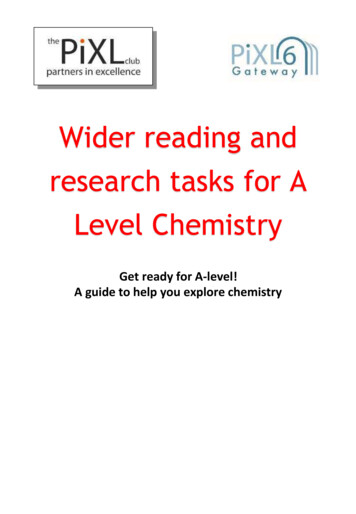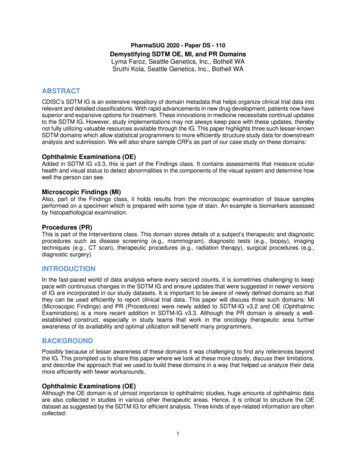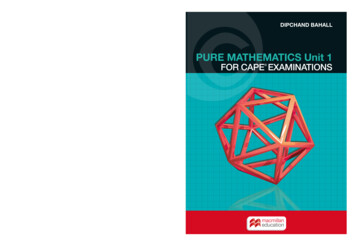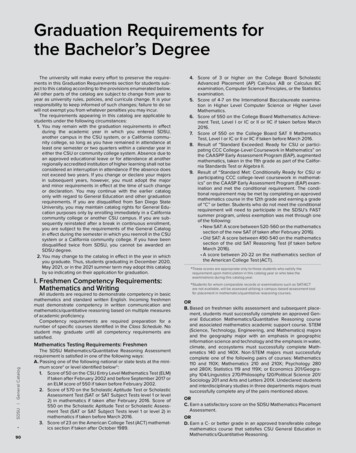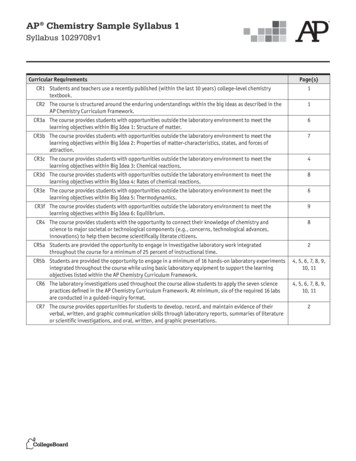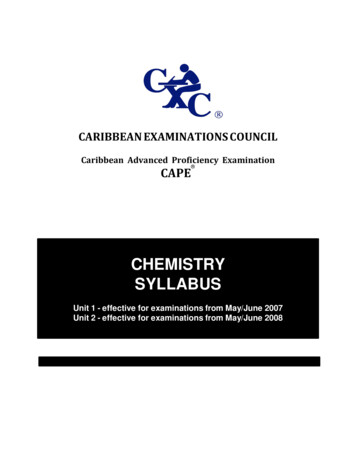
Transcription
CARIBBEAN EXAMINATIONS COUNCILCaribbean Advanced Proficiency ExaminationCAPE CHEMISTRYSYLLABUSUnit 1 - effective for examinations from May/June 2007Unit 2 - effective for examinations from May/June 2008CXC A11/U2/06
Published by the Caribbean Examinations CouncilAll rights reserved. No part of this publication may be reproduced, stored in a retrieval system, ortransmitted in any form, or by any means electronic, photocopying, recording or otherwise without priorpermission of the author or publisher.Correspondence related to the syllabus should be addressed to:The Pro-RegistrarCaribbean Examinations CouncilCaenwood Centre37 Arnold Road, Kingston 5, Jamaica, W.I.Telephone: (876) 630-5200Facsimile Number: (876) 967-4972E-mail address: cxcwzo@cxc.orgWebsite: www.cxc.orgCopyright 2006, by Caribbean Examinations CouncilThe Garrison, St Michael BB14038, BarbadosCXC A11/U2/062
TContentsRATIONALE. 1AIMS . 1 - 2SKILLS AND ABILITIES TO BE ASSESSED . 2 - 4PRE-REQUISITES OF THE SYLLABUS . 4STRUCTURE OF THE SYLLABUS . 4 - 5UNIT 1 : CHEMICAL PRINCIPLES AND APPLICATIONS IMODULE 1 : FUNDAMENTALS IN CHEMISTRY .6 - 15MODULE 2 : KINETICS AND EQUILIBRIA . 16 - 22MODULE 3 : CHEMISTRY OF THE ELEMENTS . 23 - 29UNIT 2: CHEMICAL PRINCIPLES AND APPLICATIONS IIMODULE 1 : THE CHEMISTRY OF CARBON COMPOUNDS. 30 - 37MODULE 2 : ANALYTICAL METHODS AND SEPARATION TECHNIQUES . 38 - 45MODULE 3 : INDUSTRY AND THE ENVIRONMENT . 46 - 51OUTLINE OF ASSESSMENT . 52 - 56REGULATIONS FOR PRIVATE CANDIDATES . 56 - 57REGULATIONS FOR RESIT CANDIDATES. 57ASSESSMENT GRID . 57APPENDIX 1 - GLOSSARY . 58 – 62APPENDIX 2 – DATA BOOKLET . 63 – 71CXC A11/U2/063
AMENDMENTS ARE INDICATED BY ITALICS.CXC A11/U2/064
TIntroductionThe Caribbean Advanced Proficiency Examination (CAPE) is designed to provide certification of theacademic, vocational and technical achievement of students in the Caribbean who, havingcompleted a minimum of five years of secondary education, wish to further their studies. Theexaminations address the skills and knowledge acquired by students under a flexible and articulated systemwhere subjects are organised in 1-Unit or 2-Unit courses with each Unit containing three Modules. Subjectsexamined under CAPE may be studied concurrently or singly.The Caribbean Examinations Council offers three types of certification. The first is the award of a certificateshowing each CAPE Unit completed. The second is the CAPE diploma, awarded to candidates who havesatisfactorily completed at least six Units, including Caribbean Studies. The third is the CAPE Associate Degree,awarded for the satisfactory completion of a prescribed cluster of seven CAPE Units including Caribbean Studiesand Communication Studies. For the CAPE diploma and the CAPE Associate Degree, candidates must completethe cluster of required Units within a maximum period of five years.Recognised educational institutions presenting candidates for CAPE Associate Degree in one of the nine categoriesmust, on registering these candidates at the start of the qualifying year, have them confirm in the required form, theAssociate Degree they wish to be awarded. Candidates will not be awarded any possible alternatives for which theydid not apply.CXC A11/U2/06
TChemistry Syllabus RATIONALEScience plays a major role in the evolution of knowledge. It empowers us to use creative and independentapproaches to problem solving. It arouses our natural curiosity and enables us to meet diverse, and everexpanding, challenges. It enhances our ability to inquire, seek answers, research and interpret data. Theseskills lead to the construction of theories and laws that help us to explain natural phenomena and exercisecontrol over our environment. Science is, thus, an integral component of a balanced education.The most important natural resource in the Caribbean is its people. If the Caribbean is to play an importantrole in the new global village and survive economically, a sustained development of the scientific andtechnological resources of its people is essential.This CAPE syllabus is, therefore, designed to provide a coherent course of study which addresses, in addition toa specific knowledge base, the development of related skills and attitudes. The syllabus takes into account therequirements for tertiary education at regional and international institutions. The syllabus is structured in sucha way as to ensure that students become aware of their moral, social, and ethical responsibilities, as well as thebenefits intrinsic to the practical application of scientific knowledge to careers in the scientific field.Chemical principles are currently applied to societal concerns, such as, birth control, communicable diseases,environmental pollution and depletion of natural resources. As such, chemistry is a major area of scientificstudy which impinges on and influences every facet of our daily lives - the food we eat, the clothes we wear,our health, environment and recreational activities. Chemistry is, therefore, a fundamental science, thatshould be included as a part of our science education. AIMSThe syllabus aims to enable students to:1.acquire the knowledge and understanding of chemical principles so as to be suitably prepared foremployment and for further studies at the tertiary level;2.develop the ability to communicate chemical information derived from the collection, analysis andinterpretation of data;CXC A11/U2/061
3.appreciate, understand and use the scientific method in the solving of problems;4.develop good laboratory skills and practise safety measures when using equipment and chemicalsas well as the safe disposal of chemical waste;5.apply chemical knowledge to everyday life situations;6.appreciate that some of the advances in the field of chemistry are the results of the contributionsfrom scientists in other disciplines;7.further develop the spirit of inquiry in order to continue the search for new ways in which theresources of our environment can be used in a sustainable way;8.recognise that advances in chemistry are constantly influenced by technological, economic, social,cultural and ethical factors;9.recognise the power, impact and influence which chemistry has in a modern scientific world;10.contribute to making the Caribbean numerate and scientifically literate. SKILLS AND ABILITIES TO BE ASSESSEDThe skills, students are expected to have developed on completion of this syllabus, have been groupedunder three main headings, namely:(i)(ii)(iii)Knowledge and Comprehension;Use of Knowledge;Experimental Skills.Knowledge and Comprehension (KC)KnowledgeThe ability to identify, remember and grasp the meaning of basic facts, conceptsand principles.ComprehensionThe ability to select appropriate ideas, match, compare and cite examples andprinciples in familiar situations.Use o f K no w l e d g e ( U K )ApplicationThe ability to:- use facts, concepts, principles and procedures in familiar and in novelsituations;- transform data accurately and appropriately;CXC A11/U2/062
Analysis andInterpretationuse formulae accurately for computational purposes.The ability to:Synthesis-identify and recognise the component parts of a whole and interpret therelationship among those parts;-identify causal factors and show how they interact with each other;-infer, predict and draw conclusions;-make necessary and accurate calculations and recognise the limitations andassumptions involved.The ability to:Evaluation-combine component parts to form a new and meaningful whole;-make predictions and solve problems.The ability to:-make reasoned judgements and recommendations based on the value of ideasand information and their implications.Exp e r i m e n t a l S k i l l s ( X S )Observation,Recording andReportingThe ability to:Manipulation andMeasurementuse the senses to perceive objects and events accurately;-record the results of a measurement accurately;-select and use appropriate formats and presentations, such as tables, graphsand diagrams;-organise and present a complete report in a clear and logical form usingspelling, punctuation and grammar with an acceptable degree of accuracy;-report accurately and concisely.The ability to:-CXC A11/U2/06-handle chemicals carefully and use them economically;3
Planning andDesigning-appropriately prepare materials for observation or investigation;-assemble and use simple apparatus and measuring instruments.The ability to:recognise the problem and formulate valid hypotheses;-choose appropriate experimental methods and sampling techniques;-choose appropriate apparatus;plan and execute experimental procedures in a logical and sequential formwithin the time allotted;--use controls where appropriate;-modify experimental methods after initial work or unexpected outcomes. PRE-REQUISITES OF THE SYLLABUSAny person with a good grasp of the Caribbean Secondary Education Certificate (CSEC) Chemistry andMathematics syllabuses, or the equivalent, should be able to pursue the course of study defined by thissyllabus. However, successful participation in the course of study will also depend on the possession ofgood verbal and written communication skills. STRUCTURE OF THE SYLLABUSThis syllabus is arranged into TWO Units, each made up of three Modules. Whilst each Module in eachUnit is independent, together they form a coherent course of study which should prepare candidates for theworld of work and studies at the tertiary level.Unit 1: Chemical Principles and Applications IUnit 1 is expected to be covered in 150 hours, and consists of three Modules, each requiring approximately50 contact hours. This Unit is structured as follows:Module 1Module 2Module 3CXC A11/U2/06-Fundamentals in ChemistryKinetics and EquilibriaChemistry of the Elements4
Unit 2: Chemical Principles and Applications IIUnit 2 is expected to be covered in 150 hours, and consists of three Modules, each requiring approximately50 contact hours. This Unit is structured as follows:Module 1Module 2Module 3-The Chemistry of Carbon CompoundsAnalytical Methods and Separation TechniquesIndustry and the EnvironmentThe syllabus is arranged into two (2) Units, Unit 1 which will lay foundations, and Unit 2 which expands on, andapplies, the concepts formulated in Unit 1. It is, therefore, recommended that Unit 2 be taken after satisfactorycompletion of Unit 1 or a similar course. Each Unit will be certified separately.For each Module there are general and specific objectives. The general and specific objectives indicate thescope of the content, including practical work, on which the examination will be based. However,unfamiliar situations may be presented as stimulus material in a question.Explanatory notes are provided to the right of some specific objectives. These notes provide further guidanceto teachers as to the level of detail required.The single underlining of a specific objective and its explanatory notes, indicate those areas of the syllabusthat are suitable for practical work. However, practical work should not necessarily be limited to theseobjectives.It is recommended that of the approximately 50 contact hours suggested for each Module, a minimum ofabout 20 contact hours be spent on laboratory related-activities, such as conducting experiments, makingfield trips and viewing audio-visual materials.CXC A11/U2/065
UNIT 1: CHEMICAL PRINCIPLES AND APPLICATIONS IMODULE 1: FUNDAMENTALS IN CHEMISTRYGENERAL OBJECTIVESOn completion of this Module, students should:1.understand that theories in chemistry are subject to change;2.understand the theory of atoms as a useful construct that explains the structure and behaviour ofmatter, and the impact of nuclear chemistry on society;3.understand the development of the periodic table for the classification of elements;4.appreciate that the forces of attraction between particles influence the properties and behaviour ofmatter;5.understand the mole concept;6.understand redox reactions;7.appreciate that equilibrium concepts can be applied to chemical systems;8.understand the kinetic theory;9.understand concepts associated with energy changes;10.develop the ability to perform calculations involving energy changes.SPECIFIC OBJECTIVES1.EXPLANATORY NOTESAtomic Structure and the Periodic TableStudents should be able to:1.1discuss the process of theoretical change withrespect to Dalton's atomic theory;CXC A11/U2/06Mention the criteria that are consideredwhen theories are accepted, for example, fitbetween evidence and theoretical constructs,reliability and accuracy of data, replicabilityof experiments, consensus within thescientific community, societal factors.6
UNIT 1MODULE 1: FUNDAMENTALS IN CHEMISTRY (cont’d)SPECIFIC OBJECTIVESEXPLANATORY NOTESAtomic Structure and the Periodic Table (cont’d)1.2describe the structure of the atom;1.3define the following terms:(i)mass number;(ii)isotopes;Simple treatment; properties of protons,neutrons and electrons only, their relativemasses and charges, location andtheirbehaviour in electric and magnetic fields.(iii) relative atomic and isotopic massesbased on thescale.1.4explain the phenomenon of radioactivity;1.5cite the use of radioisotopes;1.6calculate the relative atomic mass of anelement, given isotopic masses and abundances;1.7explain how data from emission spectraprovide evidence for discrete energy levelswithin the atom;Bohr model, the emission spectrum ofhydrogen; Lyman series, Balmer series; ΔE or dE hν.1.8describe the atomic orbitals;Principal quantum numbers, s, p and d orbitals;relative energies of 4s and 3d orbitals.1.9describe the shapes of the s and p orbitals;CXC A11/U2/06Write equations representing nuclear reactionsinvolving , and γ emissions;n/pratio.Positrons(r) are not required.7
UNIT 1MODULE 1: FUNDAMENTALS IN CHEMISTRY (cont’d)SPECIFIC OBJECTIVESEXPLANATORY NOTESAtomic Structure and the Periodic Table (cont’d)1.10determine the electronic configurations ofatoms and ions in terms of s, p and dorbitals;Consider elements from atomic numbers 1to 30.1.11state the factors which influence the firstionisation energy of elements;Include atomic radii, nuclear charge, shielding.1.12explain how ionisation energy data provideevidence for sub-shells;Period 3.1.13derive the electronic configuration of anelement from data on successive ionisationenergies.2.Forces of AttractionStudents should be able to:2.1state the various forces of attraction betweenparticles;2.2state the relationship between forces ofattraction and states of matter;2.3relate physical properties ofdifferences in strength ofattraction;2.4explain the formation of the following:(i)ionic bonds;(ii)covalent bonds;(iii)metallic bonds.CXC A11/U2/06matterforcestoofIonic bonds, covalent bonds, hydrogenbonds, metallic bonds, Van der Waals forces.Variation in melting points, boiling pointsand solubilities.Covalent bonds should be discussed in termsof orbital overlap which results in theformation of sigma (σ) and pi (π) bonds.Metallic bonding is to be treated as a latticeof positive ions surrounded by mobileelectrons. Electronegativity and polarity ofbonds should be included.8
UNIT 1MODULE 1: FUNDAMENTALS IN CHEMISTRY (cont’d)SPECIFIC OBJECTIVESEXPLANATORY NOTESForces of Attraction (cont’d)2.5illustrate practically the properties of ionic andcovalent compounds;Refer to melting point and boiling pointdeterminations; solubilities in polar and nonpolar solvents, electrical conductivity.2.6describebonding;Use 'dot-cross’ diagrams; refer to simplesystems (for example, BF3/NH3).2.7describe the origin of inter-molecular forces;Refer to hydrogen bonding; Van der Waalsforces, permanent dipole.2.8predict the shapes of, and bond angles insimple molecules and ions;Apply the VSEPR theory to include thefollowing systems: trigonal (for example,BF3), linear (for example, BeCl2), tetrahedral(for example, NH4 , CH4), pyramidal (forexample, H3O , CH3- , NH3), non-linear (forexample, H2O), octahedral (for example,SF6).2.9explain the shapes and bond angles ofsimple organic compounds;Ethane, ethene and benzene; apply theconcept of hybridization and resonance.2.10predict the shapes and bond angles ofmolecules similar to ethane, ethene.Simple substituted derivatives for exampledichloroethane.2.11describe qualitatively the lattice structure ofcrystalline solids and their relation tophysical properties.Simple molecular (for example, I2), hydrogenbonded (for example, ice), giant molecularexample,(for example, SiO2), ionic (forNaCl), metallic (for example, Cu), giantatomic (for example, graphite and diamond)structures.co-ordinateCXC A11/U2/06(dativecovalent)9
UNIT 1MODULE 1: FUNDAMENTALS IN CHEMISTRY (cont’d)SPECIFIC OBJECTIVES3.EXPLANATORY NOTESThe Mole ConceptStudents should be able to3.1apply Avogadro's law;3.2define the mole;3.3define the term ‘molar mass’;3.4write balanced molecular and ionic equations;3.5perform calculations based on the moleconcept;3.6apply the mole concept to molecular andionic equations;3.7calculate empirical and molecular formulae;Students may be given combustion data;absolute masses or relative abundances ofelements.3.8perform titrimetric analyses;Include acid/base titrations and redoxtitrations. (dichromate(VI), hydrogen peroxide,iodide thiosulphate, manganate(VII));mean(consecutive accurate values within 0.10cm3 ofeach other), significant figures.3.9use results from titrimetric analyses tocalculate:(i)mole ratios;(ii)molar concentration and massconcentration.CXC A11/U2/06Perform calculations involving molar volumes.10Relate to masses of substances, volumes ofgases, volumes and concentrations ofsolutions.
UNIT 1MODULE 1: FUNDAMENTALS IN CHEMISTRY (cont’d)SPECIFIC OBJECTIVES4.EXPLANATORY NOTESRedox ReactionsStudents should be able to:4.1explain redox reactions in terms of electrontransfer and changes in oxidation state(number);4.2deduce balanced equations for redoxreactions from relevant half equations;4.3perform simple displacement reactions toorder elements in terms of oxidizing orreducing ability.5.Kinetic TheoryRefer to Unit 1 Module 1 Specific Objective 3.8.Students should be able to:5.1state the basic assumptions of the kinetictheory with reference to an ideal gas;5.2explain the differences between real andideal gases;Qualitative treatment only – the conditionswhich are necessary for a gas to approachideal behaviour, the limitations of ideality atveryhighpressuresandverylowtemperatures. Include graphical representations.perform calculations using:Calculations involving the use of Van derWaals equation of state are not required.Include graphical representations.5.3(i)Boyle's law;(ii)Charles' law;(iii)the ideal gas equation(pV nRT).CXC A11/U2/06Include calculations of relative molar mass.11
UNIT 1MODULE 1: FUNDAMENTALS IN CHEMISTRY (cont’d)SPECIFIC OBJECTIVESEXPLANATORY NOTESKinetic Theory (cont’d)5.46.explain the following:(i)the liquid ents should be able to:6.1state that chemical reactions take placethrough energy changes (usually in the formof heat) associated with the breaking andmaking of bonds;Note that bond making is an exothermicprocess, that is:ΔH - vewhile bond breaking is an endothermicprocess, that is:ΔH ve.6.2State that energy changes occur in chemicalreactions associated with the making and breakingof bonds;6.3explain the differences between exothermicand endothermic reactions using energyprofile diagrams;6.4explain the term ‘bond energy’;6.5explain how bond energy data may be usedto show the relationship between strength ofcovalent bonds and reactivity of covalentmolecules;CXC A11/U2/0612Lack of reactivity of nitrogen. Considerfactors which affect bond energy.
UNIT 1MODULE 1: FUNDAMENTALS IN CHEMISTRY (cont’d)SPECIFIC OBJECTIVESEXPLANATORY NOTESEnergetics (cont’d)6.6apply concepts associated with enthalpychanges;Include enthalpy change of formation,combustion, reaction, hydration, solution,neutralisation, atomisation, ionisation energy,electron affinity and lattice energy.6.7explain the effect of ionic charge and radiuson the magnitude of lattice energy;No calculation needed.6.8state Hess’ law of constant heat summation;Use standard conditions.6.9calculate enthalpy changes from appropriateexperimental data.This will require construction of energy cyclesincluding Born Haber cycles. Data may beobtainedexperimentallyorprovided.Experiments may include heats of reaction,solution and neutralisation.Calculations involving bond energy data.Suggested Teaching and Learning ActivitiesTo facilitate students’ attainment of the objectives of this Module, teachers are advised to engage students in theteaching and learning activities listed below.Atomic Structure and the Periodic Table1.Carry out practical weighing activities which compare the mass of different objects (for example,coins) in order to develop the concept of relative mass and changing standards of comparison.2.Ask students to present the story of the discovery of the phenomenon of radioactivity (use videomaterial if available).3.Class discussion in which current examples of the impact of radioactivity in everyday life are cited(from newspaper articles and the electronic media including the Internet).4.Provide students with appropriate reading material prior to class session and teacher and studentsdiscuss the strengths and weaknesses of the Bohr and Rutherford models of the atom.CXC A11/U2/0613
UNIT 1MODULE 1: FUNDAMENTALS IN CHEMISTRY (cont’d)5.Class discussions on the evidence that led to modification of Dalton’s atomic theory and on the historicaldevelopment of the Periodic Table.Forces of Attraction1.In small groups, provide students with appropriate quantitative data and guided questions whichwill lead them to infer that forces of attraction vary in strength.2.Use ball and stick models for molecular shapes.The Mole Concept1.Use of appropriate analogies to explain that the mole is an amount of particles (atoms, molecules,ions, electrons).2.Conduct laboratory work.Re d o x Re a c t i o n s , K i n e t i c T h e o r y a n d E n e r g e t i c sUse practical activities, diagrams, graphs and guided questions.RESOURCESTeachers and students may find reference to the following resource materials useful. The latest editions arerecommended.Clarke, J.Calculations in AS/A Level Chemistry, Essex:Education Limited, 2000.Hill, G., and Holman, J.Chemistry in Context, London: Nelson Thorne Limited, 2000.Lister, T., Renshaw, J.Understanding Chemistry for Advanced Level, Cheltenham:Trans-Atlantic Publications, 2000.Ramsden, E.A-Level Chemistry, Cheltenham: Nelson Thorne Limited,2000.CXC A11/U2/0614Pearson
UNIT 1MODULE 1: FUNDAMENTALS IN CHEMISTRY uk www.creativechemistry.org.uk www.alevelchemistry.co.ukCXC A11/U2/0615
UNIT 1MODULE 2: KINETICS AND EQUILIBRIAGENERAL OBJECTIVESOn completion of this Module, students should:1.understand the concepts associated with reaction rates;2.understand the concepts of chemical equilibrium;3.appreciate that principles of kinetics and equilibria can be applied to industrial and biologicalprocesses.SPECIFIC OBJECTIVES1.EXPLANATORY NOTESRates of ReactionsStudents should be able to:1.1explain the concepts associated with reactionrates;Include a study of rate constant, order ofreaction, half-life, rate-determining step,activation energy, collision theory, (simpletreatment only), and catalysis include enzymesin industrial and biological processes.1.2design and carry out suitable experiments forstudying the factors which affect rates ofreactions;Include effects of concentration, temperatureand catalysts.Express results in the form of tables andgraphs.1.3construct rate equations of the form:Rate k [A]n[B]m limited to simple casesinvolving zero, first and second order reactions;Rate equations may be derived or deducedfrom experimental data supplied.1.4deduce the order of reaction from appropriatedata;Include deductions of possible reactionmechanisms.1.5interpret concentration against time and concentrationagainst rate for zero and first order reactions;Qualitative and quantitative treatmentsrequired.1.6perform calculations from rate data.Calculate initial rates and rate constants.CXC A11/U2/0616
UNIT 1MODULE 2: KINETICS AND EQUILIBRIA (cont’d)SPECIFIC OBJECTIVESEXPLANATORY NOTESRates of Reactions (cont’d)1.7perform simple calculations using half-life data;Limited to first order reactions.1.8explain the effect of temperature and catalysts onthe rate of the reaction using Boltzmanndistribution of energies (and of collisionfrequency).Include the use of Boltzmann distributioncurves.2.Principles of Chemical EquilibriumStudents should be able to:2.1explain the concept of dynamic equilibrium;2.2state the characteristics of a system in dynamicequilibrium;2.3define the terms Kc and Kp;2.4perform a simple experiment to determine thevalue of Kc for a mconstants in terms of concentration, (Kc) andpartial pressure, (Kp).Conversion of Kc to Kp is not required.Quadratic equations are not required.2.6apply Le Chatelier's principle to explain the effectsof changes in temperature, concentration andpressure on a system in equilibrium;Include reference to the characteristics of asystem in dynamic equilibrium.2.7interpret how changes in concentration, pressure,temperature or the presence of a catalyst mayaffect the value of the equilibrium constant;Include references to the Haber Process andthe Contact Process.CXC A11/U2/06Refer to physical and chemical processes.Write equilibrium constant expressions in termsof Kc and Kp.17
UNIT 1MODULE 2: KINETICS AND EQUILIBRIA (cont’d)SPECIFIC OBJECTIVES3.EXPLANATORY NOTESAcid/Base EquilibriaStudents should be able to:3.1explain the differences in behaviour of strong andweak acids and bases, using Bronsted-Lowry theory;3.2define the terms Ka, pH, pKa, and pKb, Kw and pKw;3.3perform calculations involving pH, Ka, pKa Kw andpKw, Kb and pKb;Quadratic equations are not required.3.4describe the changes in pH during acid/basetitrations;Include a study of titration curves.3.5explain what is meant by the pH range of indicator;3.6state the basis for the selection of acid-base indicator foruse in titrations.3.7perform experiments to show that the effectivenessof different indicators is related to the pH changeswhich occur during titration.4.Buffers and pHStudents should be able to:4.1define the term ‘buffer solution’;4.2explain how buffer solutions control pH;4.3calculate the pHappropriate data;4.4perform simple experiments to determine the pHof buffer solutions;ofCXC A11/U2/06buffersolutions from18Include phenolphthalein and methyl orange.Titration curves.
UNIT 1MODULE 2: KINETICS AND EQUILIBRIA (cont’d)SPECIFIC OBJECTIVESEXPLANATORY NOTESBuffers and pH (cont’d)4.5discuss the importance of buffers in biologicalsystems and in industrial processes.5.Solubility ProductInclude reference to blood buffer systemssuch as hydrogencaronale, phosphate and aminoacid systems, enzyme catalysed reactions andthe food processing industry.Students should be able to:5.1define the term solubility product, Ksp5.2explain the principles underlyingproduct and the common ion effect;5.3perform calculations involving solubility product;5.4perform a simple experiment to determine thesolubility product of a substance;5.5relate the solubility product principle to theselective precipitation of substances.6.Redox EquilibriaWrite equilibrium constant expression for KspsolubilityQuadratic equations are not required.Include reference to qualitative analysis andkidney stone formation.Students should be able to:6.1define the terms standard electrode potential andstandard cell potential;6.2describe the standard hydrogen electrode;CXC A11/U2/06Include labelled diagram of standard hydrogenelectrode.19
UNIT 1MODULE 2: KINETICS AND EQUILIBRIA (cont’d)SPECIFIC OBJECTIVESEXPLANATORY NOTESRedox Equilibria (cont’d)6.3describe methods used to measure the standardelectrode potentials of:(i)metals or non-metals in contact withtheir ions in aqueous solutions;(ii)ions of the same element in differentoxidation states;6.4calculate standard cell potentials from standardelectrode potentials of two half cells;6.5use standard electrode potentials of cells:Include labelled diagrams of electrochemicalcells.Include cell diagram or notation of the typeZn
CHEMISTRY SYLLABUS. Unit 1 - effective for examinations from May/June 2007 Unit 2 - effective for examinations from May/June 2008 . study which impinges on and influences every facet of our daily lives - the food we eat, the clothes we wear, our health, environment and recreational activities. Chemistry is, therefore, a fundamental science .



